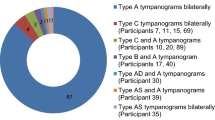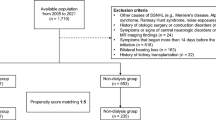Abstract
Background
Children with idiopathic nephrotic syndrome (INS) are at risk of hearing impairment due to nephrotoxic drugs and biochemical impairments.
Methods
Forty children with INS aged 5–16 years [20 patients with frequently relapsing nephrotic syndrome (FRNS)/steroid dependent nephrotic syndrome (SDNS) and 20 with steroid resistant nephrotic syndrome (SRNS)] and 20 normal healthy controls were enrolled in this study. Pure tone audiometry was done using the ALPS AD 2000 audiometer. Sensorineural hearing loss was diagnosed when the bone conduction level was >20 dB and the difference in air to bone gap was ≤15 dB. Based on the air conduction (AC) threshold, deafness was graded into the following categories: mild (26–40 dB), moderate (41–55 dB), moderately severe (56-70 dB), severe (71–91 dB) and profound (>91 dB).
Results
Children with FRNS/SDNS had a higher threshold for hearing at frequencies of 250 and 500 Hz, respectively, than the controls. Of the children in the FRNS/SDNS category, three (15 %) had mild sensorineural hearing impairment. These children had a low serum calcium level (P < 0.03) and received higher cumulative doses of furosemide (P < 0.04). Children with SRNS had a higher threshold for hearing at frequencies of 250, 500, 1,000, and 2,000 Hz, respectively, than the controls. Of the 20 children with SRNS, ten (50 %) had sensoineural hearing impairment (8 mild, 2 moderate). Children with SRNS with a hearing defect had received a higher cumulative dose of furosemide (P < 0.03).
Conclusions
Children with FRNS/SDNS and SRNS are at risk of sensorineural hearing impairment. The risk factors associated with this impairment were higher cumulative doses of furosemide and hypocalcemia. Larger prospective cohort studies are required to evaluate this association.


Similar content being viewed by others
References
Eddy AA, Symons JM (2003) Nephrotic syndrome in childhood. Lancet 362:629–639
Indian Pediatrics Nephrology Group, Indian Academy of Pediatrics (2008) Management of steroid sensitive nephrotic syndrome: Revised guidelines. Indian Pediatr 45:203–214
Bergstrom L, Thompson P, Wood RP (1979) New patterns in genetic and congenital nephropathies. Laryngoscope 2:309–322
Cremer CW, Flikkers-Van Noord M (1980) The ear pits-deafness syndrome. Clinical and genetic aspects. Int J Pediatr Otorhinolaryngol 2:309–322
Saito R, Takata N, Matsumoto N, Koide I, Fujita A, Ogura Y, Murakami M, Yanagida K, Komazawa M (1982) Anomalies of the auditory organ in Potter’s syndrome. Histopathological findings in the temporal bone. Arch Otolaryngol 108:484–488
Quick CA, Fish A, Brown C (1973) The relationship between cochlea and kidney. Laryngoscope 83(9):1469–1482
Kumar S, Chakravarti A, Sahni J, Dubey NK, Rathore R (2004) Auditory brain stem evoked response (ABR) study in patients with pediatric chronic renal failure undergoing peritoneal dialysis. Indian J Otol 9:24–27
Aryan CE, Clapp WL, Redman RS, Dharnidharka VR (2006) Hearing loss in renal failure differential diagnosis. Am J Kidney Dis 47(3):553–558
Thodi C, Thodis E, Danielides V, Pasadakis P, Vargemezis V (2006) Hearing in renal failure. Nephrol Dial Transplant 21:3023–3030
Sato KA, Gray RW, Lemann J Jr (1982) Urinary excretion of 25-hydroxyvitamin D in health and the nephrotic syndrome. J Lab Clin Med 99(3):325–330
Freundlich M, Bourgoignie JJ, Zilleruelo G, Abitbol C, Canterbury JM, Strauss J (1986) Calcium and vitamin D metabolism in children with nephrotic syndrome. J Pediatr 108(3):383–387
Baxter JH, Goodman HC, Havel RJ (1960) Serum lipid and lipoprotein alteration in nephrosis. J Clin Invest 39:455–465
Kaysen GA (1991) Hyperlipidemia of the nephrotic syndrome. Kidney Int 31[Suppl]:S8–S15
Bayazit YA, Balat A, Pakir HI, Güler E, Kanlikama M (2005) Influence of relapse and remission periods on hearing status in children with minimal change nephrotic syndrome. Rev Laryngol Otol Rhinol 126(3):171–173
Orendorz-Frqczkowska K, Medynska A, Jablonka A, Gawron W (2008) Hearing organ function in children with nephrotic syndrome in course of primary glomerulopathy. Otolaryngologia Polska 12:182–187
Bushinsky DA, Monk RD (1998) Electrolyte quintet: calcium. Lancet 352:306–311
Carhart R, Jerger J (1959) Preferred method for clinical determination of pure tone thresholds. J Speech Hear Res 24:330–345
Clark JG (1981) Uses and abuses of hearing loss classification. ASHA 23(7):493–500
Indian Pediatric Nephrology Group, Indian Academy of Pediatrics (2009) Management of steroid resistant nephrotic syndrome: guidelines. Indian Pediatr 46:35–47
Brookes GB (1983) Vitamin D deficiency- a new cause of cochlear deafness. J Laryngol Otol 97(5):405–420
Ikeda K, Kusakari J, Kobayashi T, Saito Y (1987) The effect of vitamin D deficiency on the cochlear potentials and the perilymphatic ionized calcium concentration of rats. Acta Otolaryngol Suppl 435:64–72
Ikeda K, Kobayashi T, Kusakari J, Takasaka T, Yumita S, Furukawa Y (1987) Sensorineural hearing loss associated with hypoparathyroidism. Laryngoscope 97(9):1075–1079
Iwanaga M, Yamamoto E, Yamauchi M (1983) Effect of calcium on AP (N1) and ABR in thyroid and parathyroid dysfunction. Audiology 26:171–177
Chodynicki S, Kostrzewska A (1974) Effect of furosemide and ethacrynic acid on endolymph potential in guinea pigs. Otolaryngol Pol 28:5–8
Green TP, Rybak LP, Mirkin BL, Juhn SK, Morizono T (1981) Pharmacologic determinants of ototoxicity of furosemide in the chinchilla. J Pharmacol Exp Ther 216:537–542
Sewell WF (1984) The relation between the endocochlear potential and spontaneous activity in auditory nerve fibres of the cat. J Physiol 347:685–696
Koch T, Gloddek B (1991) Inhibition of adenylate-cyclase-coupled G protein complex by ototoxic diuretics and cis-platinum in the inner ear of the guinea pig. Eur Arch Otorhinolaryngol 248:459–464
Quick CA, Hoppe W (1975) Permanent deafness associated with furosemide administration. Ann Otol Rhinol Laryngol 84:94–101
Forge A (1976) Observations on the stria vascularis of the guinea pig cochlea and the changes resulting from the administration of the diuretic furosemide. Clin Otolaryngol Allied Sci 1:211–219
Rarey KE, Ross MD (1982) A survey of the effects of loop diuretics on the zonulae occludentes of the perilymph-endolymph barrier by freeze fracture. Acta Otolaryngol 94:307–316
Rybak LP (1993) Ototoxicity of loop diuretics. Otolaryngol Clin North Am 26:829–844
Rybak LP, Whitworth C, Scott V (1993) Furosemide ototoxicity is enhanced in analbuminemic rats. Arch Otolaryngol Head Neck Surg 119:758–761
Author information
Authors and Affiliations
Corresponding author
Rights and permissions
About this article
Cite this article
Saha, A., Gupta, V., Kapoor, K. et al. Hearing status in children with frequently relapsing and steroid resistant nephrotic syndrome. Pediatr Nephrol 28, 439–445 (2013). https://doi.org/10.1007/s00467-012-2358-7
Received:
Revised:
Accepted:
Published:
Issue Date:
DOI: https://doi.org/10.1007/s00467-012-2358-7




